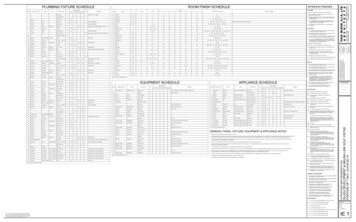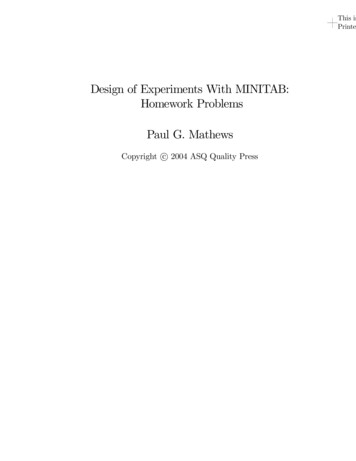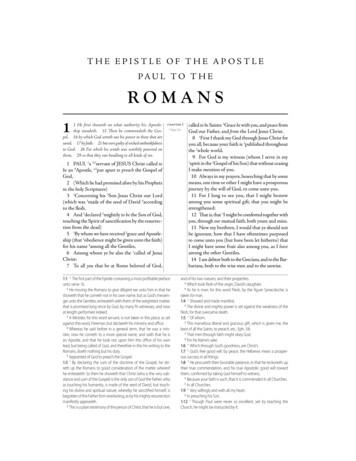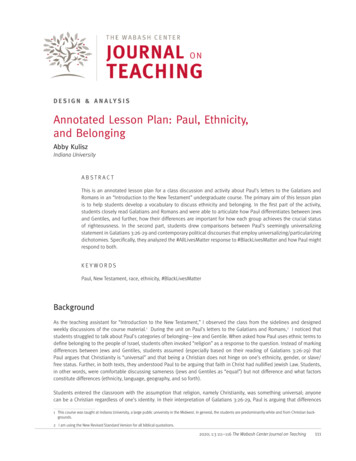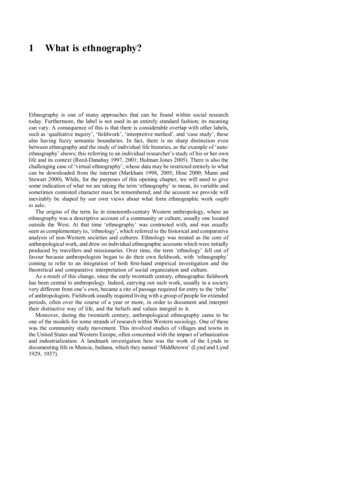
Transcription
940123456741EEE1What is ethnography?Ethnography is one of many approaches that can be found within social researchtoday. Furthermore, the label is not used in an entirely standard fashion; its meaningcan vary. A consequence of this is that there is considerable overlap with other labels,such as ‘qualitative inquiry’, ‘fieldwork’, ‘interpretive method’, and ‘case study’, thesealso having fuzzy semantic boundaries. In fact, there is no sharp distinction evenbetween ethnography and the study of individual life histories, as the example of ‘auto/ethnography’ shows; this referring to an individual researcher’s study of his or her ownlife and its context (Reed-Danahay 1997, 2001; Holman Jones 2005). There is also thechallenging case of ‘virtual ethnography’, whose data may be restricted entirely to whatcan be downloaded from the internet (Markham 1998, 2005; Hine 2000; Mann andStewart 2000). While, for the purposes of this opening chapter, we will need to givesome indication of what we are taking the term ‘ethnography’ to mean, its variable andsometimes contested character must be remembered; and the account we provide willinevitably be shaped by our own views about what form ethnographic work oughtto take.The origins of the term lie in nineteenth-century Western anthropology, where anethnography was a descriptive account of a community or culture, usually one locatedoutside the West. At that time ‘ethnography’ was contrasted with, and was usuallyseen as complementary to, ‘ethnology’, which referred to the historical and comparativeanalysis of non-Western societies and cultures. Ethnology was treated as the core ofanthropological work, and drew on individual ethnographic accounts which were initiallyproduced by travellers and missionaries. Over time, the term ‘ethnology’ fell out offavour because anthropologists began to do their own fieldwork, with ‘ethnography’coming to refer to an integration of both first-hand empirical investigation and thetheoretical and comparative interpretation of social organization and culture.As a result of this change, since the early twentieth century, ethnographic fieldworkhas been central to anthropology. Indeed, carrying out such work, usually in a societyvery different from one’s own, became a rite of passage required for entry to the ‘tribe’of anthropologists. Fieldwork usually required living with a group of people for extendedperiods, often over the course of a year or more, in order to document and interprettheir distinctive way of life, and the beliefs and values integral to it.Moreover, during the twentieth century, anthropological ethnography came to beone of the models for some strands of research within Western sociology. One of thesewas the community study movement. This involved studies of villages and towns inthe United States and Western Europe, often concerned with the impact of urbanizationand industrialization. A landmark investigation here was the work of the Lynds indocumenting life in Muncie, Indiana, which they named ‘Middletown’ (Lynd and Lynd1929, 1937).
2 What is ethnography?In a parallel development, many sociologists working at the University of Chicagofrom the 1920s to the 1950s developed an approach to studying human social life thatwas similar to anthropological research in some key respects, though they often labelledit ‘case study’. The ‘Chicago School’ was concerned with documenting the range ofdifferent patterns of life to be found in the city, and how these were shaped by thedeveloping urban ecology.From the 1960s onwards, forms of sociological work influenced by these developments, especially by Chicago sociology, spread across many sub-fields of the discipline,and into other disciplines and areas of inquiry as well; and they also migrated fromthe United States to Europe and to other parts of the world. Furthermore, for a varietyof reasons, an increasing number of anthropologists began to do research within Westernsocieties, at first in rural areas but later in urban locales too.1 Another relevant development in the latter half of the twentieth century was the rise of cultural studies as anarea of investigation distinct from, but overlapping with, anthropology and sociology.Work in this field moved from broadly historical and textual approaches to includethe use of ethnographic method, notably in studying audiences and the whole issue ofcultural consumption. Furthermore, in the later decades of the twentieth century, ethnography spread even further, for example into psychology and human geography. Indeed,it tended to get swallowed up in a general, multidisciplinary, movement promotingqualitative approaches; though the term ‘ethnography’ still retains some distinctiveconnotations.2This complex history is one of the reasons why ‘ethnography’ does not have astandard, well-defined meaning. Over the course of time, and in each of the variousdisciplinary contexts mentioned, its sense has been reinterpreted and recontextualizedin various ways, in order to deal with particular circumstances. Part of this remouldinghas arisen from the fact that ethnography has been associated with, and also put inopposition to, various other methodological approaches. Furthermore, it has beeninfluenced by a range of theoretical ideas: anthropological and sociological functionalism,philosophical pragmatism and symbolic interactionism, Marxism, phenomenology,hermeneutics, structuralism, feminism, constructionism, post-structuralism and postmodernism. Increasingly, it has been compared and contrasted not just with experimentaland survey research but also with interview-based studies, macro-historical analysis,political economy, conversation and discourse analysis, and psycho-social approaches.In short, ‘ethnography’ plays a complex and shifting role in the dynamic tapestrythat the social sciences have become in the twenty-first century. However, this termis by no means unusual in lacking a single, standard meaning. Nor does the uncertaintyof sense undermine its value as a label. And we can outline a core definition, whilerecognizing that this does not capture all of its meaning in all contexts. In doing thiswe will focus, initially, at a fairly practical level: on what ethnographers actually do,on the sorts of data that they usually collect, and what kind of analysis they deployto handle those data. Later we will broaden the discussion to cover some of the ideasthat have informed, and continue to inform, ethnographic practice.1 For an account of the development and reconfiguration of ethnographic work within British anthropology,see Macdonald (2001).2 Diverse strands and trends of the qualitative research movement are exemplified in the various editionsof the Handbook of Qualitative Research: Denzin and Lincoln (1994, 2000, 2005).
What is 893012345678940123456741EEE3What ethnographers doIn terms of data collection, ethnography usually involves the researcher participating,overtly or covertly, in people’s daily lives for an extended period of time, watchingwhat happens, listening to what is said, and/or asking questions through informal andformal interviews, collecting documents and artefacts – in fact, gathering whateverdata are available to throw light on the issues that are the emerging focus of inquiry.Generally speaking ethnographers draw on a range of sources of data, though theymay sometimes rely primarily on one.3In more detailed terms, ethnographic work usually has most of the following features:12345People’s actions and accounts are studied in everyday contexts, rather than underconditions created by the researcher – such as in experimental setups or in highlystructured interview situations. In other words, research takes place ‘in the field’.Data are gathered from a range of sources, including documentary evidence ofvarious kinds, but participant observation and/or relatively informal conversationsare usually the main ones.Data collection is, for the most part, relatively ‘unstructured’, in two senses. First,it does not involve following through a fixed and detailed research design specifiedat the start. Second, the categories that are used for interpreting what people sayor do are not built into the data collection process through the use of observationschedules or questionnaires. Instead, they are generated out of the process of dataanalysis.The focus is usually on a few cases, generally fairly small-scale, perhaps a singlesetting or group of people. This is to facilitate in-depth study.The analysis of data involves interpretation of the meanings, functions, andconsequences of human actions and institutional practices, and how these areimplicated in local, and perhaps also wider, contexts. What are produced, for themost part, are verbal descriptions, explanations, and theories; quantification andstatistical analysis play a subordinate role at most.As this list of features makes clear, as regards what is referred to in methodologicaltexts as ‘research design’, ethnographers typically employ a relatively open-endedapproach (see Maxwell 2004b). They begin with an interest in some particular area ofsocial life. While they will usually have in mind what the anthropologist Malinowski– often regarded as the inventor of modern anthropological fieldwork – called‘foreshadowed problems’, their orientation is an exploratory one. The task is toinvestigate some aspect of the lives of the people who are being studied, and thisincludes finding out how these people view the situations they face, how they regardone another, and also how they see themselves. It is expected that the initial interestsand questions that motivated the research will be refined, and perhaps even transformed,over the course of the research; and that this may take a considerable amount of time.Eventually, through this process, the inquiry will become progressively more clearlyfocused on a specific set of research questions, and this will then allow the strategic3 These methods can include those that are ‘unobtrusive’: Lee (2000). There has been some disputeabout whether ethnographic studies can rely entirely on interview or documentary data, withoutcomplementary participant observation. See Atkinson and Coffey (2002).
4 What is ethnography?collection of data to pursue answers to those questions more effectively, and to testthese against evidence.Collecting data in ‘natural’ settings, in other words in those that have not beenspecifically set up for research purposes (such as experiments or formal interviews)also gives a distinctive character to ethnographic work. Where participant observationis involved, the researcher must find some role in the field being studied, and this willusually have to be done at least through implicit, and probably also through explicit,negotiation with people in that field. Access may need to be secured through gatekeepers,but it will also have to be negotiated and renegotiated with the people being studied;and this is true even where ethnographers are studying settings in which they arealready participants. In the case of interviewing, too, access cannot be assumed to beavailable automatically, relations will have to be established, and identities coconstructed.The initially exploratory character of ethnographic research means that it will oftennot be clear where, within a setting, observation should be begin, which actors need tobe shadowed, and so on. Sampling strategies will have to be worked out, and changed,as the research progresses. Much the same is true of the use of interviews. Here, decisionsabout whom to interview, when, and where, will have to be developed over time, andthe interviewing will normally take a relatively unstructured form, though more structuredor strategic questioning may be used towards the end of the fieldwork. Furthermore, asalready noted, the data will usually be collected in an unstructured form, by meansof fieldnotes written in concretely descriptive terms and also through audio- or videorecordings, plus the collection of documents. Given the nature of these data, a considerableamount of effort, and time, will need to go into processing and analysing them. In allthese respects, ethnography is a demanding activity, requiring diverse skills, includingthe ability to make decisions in conditions of considerable uncertainty.This is true despite the fact that, as a set of methods, ethnography is not far removedfrom the means that we all use in everyday life to make sense of our surroundings, ofother people’s actions, and perhaps even of what we do ourselves. What is distinctiveis that it involves a more deliberate and systematic approach than is common for mostof us most of the time, one in which data are specifically sought to illuminate researchquestions, and are carefully recorded; and where the process of analysis draws on previousstudies and involves intense reflection, including the critical assessment of competinginterpretations. What is involved here, then, is a significant development of the ordinarymodes of making sense of the social world that we all use in our mundane lives, in amanner that is attuned to the specific purposes of producing research knowledge.In the remainder of this chapter we will explore and assess a number ofmethodological ideas that have shaped ethnography. We shall begin by looking at theconflict between quantitative and qualitative method as competing models of socialresearch, which raged across many fields in the past and still continues in some eventoday. This was often seen as a clash between competing philosophical positions.Following some precedent we shall call these ‘positivism’ and ‘naturalism’: the formerprivileging quantitative methods, the latter promoting ethnography as the central, ifnot the only legitimate, social research method.4 After this we will look at more recent4 ‘Naturalism’ is a term which is used in a variety of different, even contradi
hwkqrjudsk\¶ vkrzv wklv uhihuulqj wr dq lqglylgxdo uhvhdufkhu¶v vwxg\ ri klv ru khu rzq olih dqg lwv frqwh[w 5hhg 'dqdkd\ ropdq -rqhv 7khuh lv dovr wkh fkdoohqjlqj fdvh ri µyluwxdo hwkqrjudsk\¶ zkrvh gdwd pd\ eh uhvwulfwhg hqwluho\ wr zkdw fdq eh grzqordghg




